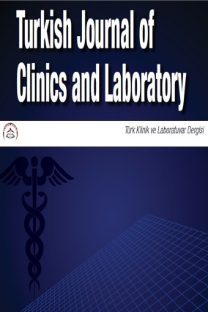Yoğun Bakım Ünitelerinde Çalışan Hemşirelerin Kaf Basıncı Eğitim Yeterliliği
endotrakeal tüp, kaf basıncı, kaf eğitimi, kaf cimnastiği
Cuff pressure training competence of nurses working in intensive care units
endotracheal tube, cuff pressure, cuff training, cuff exercise,
___
- Saracoglu A, Dal D, Pehlivan G, Yılmaz F. The Professional Experience of Anaesthesiologists in Proper Inflation of Laryngeal Mask and Endotracheal Tube Cuff .Turk J Anaesth Reanim 2014; 42: 234-38.
- Seyed Siamdoust SA, Mohseni M, Memarian A.Endotracheal Tube Cuff Pressure Assessment: Education May Improve but not Guarantee the Safety of Palpation Technique. Anesthesiol Pain Med. 2015 Jun;5(3):e16163.
- Ozcan ATD, Doger C, But A, Kutlu I, Aksoy SM. Comparison of endotracheal tube cuff pressure values before and after training seminar. J Clin Monit Comput. 2018 Jun;32(3):527–31.
- Stewart SL, Secrest JA, Norwood BR, Zachary R. A comparison of endotracheal tube cuff pressures using estimation techniques and direct intracuff measurement. AANA J. 2003 Dec;71(6):443–47.
- Fernandez R, Blanch L, Mancebo J, Bonsoms N, Artigas A. Endotracheal tube cuff pressure assessment: pitfalls of finger estimation and need for objective measurement. Crit Care Med. 1990 Dec;18(12):1423–26.
- Ozer AB, Demirel I, Gunduz G, Erhan OL. Effects of user experience and method in the inflation of endotracheal tube pilot balloon on cuff pressure. Niger J Clin Pract. 2013;16(2):253–57.
- Danielis M, Benatti S, Celotti P, De Monte A, Trombini O. Continuous monitoring of endotracheal tube cuff pressure: best practice in intensive care unit Crit Care 2014 Sep 6;18(5):512.
- Totonchi Z, Jalili F, Hashemian SM, Jabardarjani HR.Tracheal Stenosis and Cuff Pressure: Comparison of Minimal Occlusive Volume and Palpation Techniques. Tanaffos 2015; 14(4): 252-56.
- Tekin YE, İyigün E. Investigation of the Nurses Tracheostomy/Endotracheal Tube Cuff Pressure Practices in Intensive Care Units. Turkiye Klinikleri J Nurs Sci 2016;8(1):26-33.
- ISSN: 2149-8296
- Yayın Aralığı: 4
- Başlangıç: 2010
- Yayıncı: DNT Ortadoğu Yayıncılık AŞ
Murathan KÖKSAL, Erdem ÖZKAN, Adalet AYPAK, Esragül AKINCI, Bircan KAYAASLAN, İmran HASANOĞLU, Ayşe KAYA KALEM, Fatma ESER, Fatma Gül İMAMOĞLU BAYRAKTAR, Hatice Rahmet GÜNER
Ahmet ALYANAK, Ferit ASLAN, Hakan ALAGÖZLÜ
Silikozis Hastalığı Tanısında Toraks Ultrasonu ve Görüntü işlemi Yöntemi Kullanılması
Zamir Kemal ERTÜRK, Sinan Cem UZUNGET, Tarık BARAN, Sezen BAĞLAN UZUNGET
Spontan intraserebral hemorajili hastalarda cerrahi ve medikal tedavilerin kıyaslanması
Ülkü SİYAH, Salih CESUR, Ayşe BÜYÜKDEMİRCİ, Cigdem ATAMAN HATİPOGLU, Sami KINIKLI
Cemil YÜKSEL, Serdar ÇULCU, Selim TAMAM, Elifcan HABERAL, Bülent AKSEL, Lütfi DOĞAN
Çiğdem ATAMAN HATİPOGLU, Sami KINIKLI, Ülkü ÖZTOPRAK SİYAH, Salih CESUR, Ayşe BÜYÜKDEMİRCİ
Yoğun Bakım Ünitelerinde Çalışan Hemşirelerin Kaf Basıncı Eğitim Yeterliliği
Güler ERASLAN DOĞANAY, Mukaddes KILINÇ, Esra ARSLANOĞLU, Mustafa Özgür CIRIK, Ali ALAGÖZ, Gülşah YURTSEVEN, Ebru BİLGİN
Behiye Deniz KOSOVALI, Fatma İrem YEŞİLER, Ümit Gökhan ŞENDUR, Osman YÜKSEKYAYLA
